Siegfried Marcus Part II: The Automobile and The Internal Combustion Engine
Fact Paper 32-II
© Samuel Kurinsky, all rights reserved
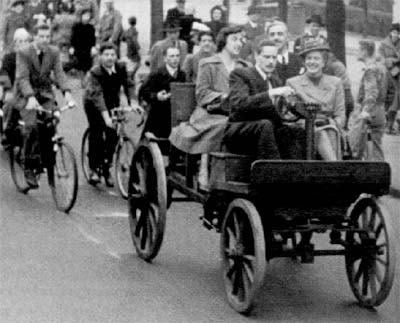
- Personal Facts About Siegfried Marcus
- The Explosion-Motor
- The Carburetor
- Electro-Magnetic Ignition
- The Motor Mechanism
- The Four-stroke Engine
- The Landmark Motor-Car of 1875
- A Prolific Inventor
- Notes
Personal Facts About Siegfried Marcus
In the title of chapter 3 of Die Automobile des Siegfried Marcus, Martin Buberl terms Marcus as "One of the Greatest Geniuses of the Nineteenth Century." Yet there is little information made available about Marcus' personal life. Dr. Gustav Goldbeck, in Siegfried Marcus, Ein Erfinderleben ("Siegfried Marcus, the life of an inventor"), lauds Marcus in the same superlative terms, but is equally uninformative about his personal life. There is good reason for this hiatus, for a massive destruction of the records of the Jewish communities of Germany and Austria took place during the Nazi period. Additionally, special emphasis was placed on re-writing history so as to depict the Germans as inherently a "Master Race," and other "races," particularly the Jews, as inferior and even so corrupt as to deserve annihilation. The obliteration of community and other records of such peoples, especially of the notable contributors to the advance of civilization by such people was essential to the Nazi scheme.
Himmler's main focus was the legitimizing of such a re-ordering of history. He engaged hundreds of scientists, and in particular archeologists, to skew history to the Nazi purpose. To the shame of a large proportion of the German scientific community, they not only enthusiastically involved themselves in outrageously fraudulent new research, but participated in deleting or corrupting the records of past science, research, and invention. German and Austrian libraries are replete with dubious scientific and historical works of this period. Some such works are still given credence by naive contemporary researchers.
Had the Nazi historical initiative not been brought to a close, a clean sweep of institutional archives and of literature would have followed. Researchers like Buberl and Goldbeck are obliged to cull information about Siegfried Marcus and the non-technological circumstances of his life from surviving articles about Marcus' inventions in nineteenth-century technical and scientific magazines, from catalogs of the expositions in which Marcus' inventions appeared, and from surviving patent applications. Even these sources have been compromised. For example, all the files of the two patent agents Marcus employed for registering his patents are gone. Again, the records of engineering firm of Siemens and Halske are missing for the three years during which young Marcus was employed.
A copy of Marcus' last will and testament, however, has survived, and from it we learn some vital facts. We may owe its survival to the circumstance that it was not registered in a Judaic archive since his common-law spouse was not Jewish and his daughters were baptized as Christians.The will was signed by Marcus on May 4, 1886, and begins with his statement that, being in very poor health but in full possession of his mental faculties, it was necessary to draw up a final will.
Marcus divided his estate (other than his factory and certain small bequests) into four parts. One-fourth was bequeathed to the mother of his two daughters, Fraulein [Miss!] Eleonore Baresch.
A second quarter was bequeathed to his daughter, born on October 4, 1861, and baptized as Eleanore Marie Baresch.
Two-fourths of his estate was bequeathed to his younger daughter, born on April 6, 1869 and baptized as Rosa Marie Baresch.
Marcus bequeathed his golden watch and chain to his brother, Emanuele Marquis [!], of Greencastle, Indiana, America.
He bequeathed his emerald and diamond-studded ring to his niece, Minna Marcus, daughter of his brother Eduard Marcus, who had died in Hamburg.
He also bequeathed to his youngest daughter, Rosa, jewelry presented to him by Crown Prince Joseph of Austria consisting of two cufflinks and two shirt-links set with diamonds and blue stones.
Marcus bequeathed his factory to engineer Hans Baresch, brother of Eleonore Baresch and "uncle of both my daughters," together with all its machinery and unfinished goods, on condition that Hans agreed to furnish yearly two hundred and fifty gulden to be divided equally between Eleonore Baresch and her two daughters. The finished goods were to be included in his other assets.
If Hans Baresch did not agree to assume this responsibility then the factory and all its equipment and goods would become part of the divided assets.1
The will is the most revealing document about Marcus' personal life provided by his biographers. It vividly underscores our ignorance of the life of a man aside from information that can be extracted about his inventions from esoteric technological sources.
It appears from some references that, in the latter part of Marcus life, perhaps in deference to his common-law wife and his daughters, he subscribed to evangelism.A poignant glimpse into Marcus' personal life is provided by a surviving letter from a friend of Marcus' granddaughter, Clementine Schmid, written after his death in 1898:1a
...Mr. Markus always came by cab to visit his daughter and grandchildren, and children from the neighborhood would then come by, for they always were given from 10-20 Kreutzer. It was always a grand occasion when "grandpa" came by - my sister and I also called him grandpa - he would put his grandchildren and us into his cab and we all rode out to lunch. We all became well known at the Hotel Kummer Mariahilferstrasse, the Restaurant Kürer am Ring, Kaffee Kremser etc...
He often told us how he drove his auto for the first time on Mariahilferstrasse and was stopped by the police because he was driving without a horse. The stethoscope for doctors was also his invention, and he also told us about his firearm that could shoot 30 bullets per minute. He told us about so many other inventions that I cannot recall them all. He also told us about the gifts Crown Prince Rudolf gave him, golden cufflinks and three golden shirt-links, all set with diamonds.
My sister and I would enjoy each holy evening with his family and were also given a present. The Markus family would spend each summer vacation in Speising, and I was always with them there.
Unfortunately my friend died in 1897 at 19 years of age. Herr Markus died in 1898, and unfortunately I was in Hungary at the time...
Clementine Schmid
Thus we learn that Marcus, if he did not invent the stethoscope, had at least developed an improved model of the instrument.
The first documented use of a stethoscope (from the Greek words for "the chest" and "I see"), was in 1817 by Laennec. This simple monaural horn evolved from Laennec's use of a roll of paper to listen to a patients heart without embarrassing her in that Victorian age by placing his head between her breasts. The device was used by some doctors in its crude horn form for the next half century. Dr. George Cammann of New York marketed the first recognized usable binaural stethoscope in 1855. The two ear-pieces were designed for two people to listen at the same time. Dr. Cammann did not claim to have the original idea for a binaural stethoscope, only to have improved it. The model he employed came from Europe.
The question remains: "What role did Marcus actually play in the development of the stethoscope.?"
In 1852 Marcus became an assistant to the Profes-sor Karl Ludwig, a renowned physiology and physics professor at the medical division of the Prince Joseph Academy Physics Institute. In the productive period that followed, young Marcus created a number of wide-ranging inventions. In 1855 alone he is known to have invented an "Apparatus to achieve even temperatures in a gas-lamp," "spirit lamp bulb," "artigraph" and a "telegraph indicator."1b
The Explosion-Motor
No invention is produced in a sociological vacuum. A brief glance into history will make clear, however, why it was the ingenious inventions of Siegfried Marcus that propelled engine and automotive technologies onto a new level of development and the industrial revolution into a new era.
Human effort to utilize natural energy marks the birth of civilization. Civilization was foreshadowed when the first fire was lit by human hand. Fire and the sun's rays were thereafter employed to bake bricks and bread, and wind was employed to propel man across the waters.
In 1335, an Italian, Guido da Vigevano, produced several designs in which he proposed to harness the wind by gearing a windmill to a wheeled vehicle. Similar designs were produced shortly thereafter by another Italian, Vaturio. A third Italian, Leonardo da Vinci, more familiar to us for his art than for his hundreds of imaginative mechanisms, likewise envisioned the harnessing of the wind. He also designed an elaborate machine, moved by a system of springs, that would enhance muscle-power. Da Vinci's automotive wagon was equipped with a differential transmission, a clockwork-type gear connection to its wheels and it was steered with a tiller.
In China, steam-powered vehicles were reported to be in operation almost three thousand years ago! As early as 800 BCE, the Chinese recognized the power of steam, and a description of a steam-powered cart appeared in the writings of the Chou Dynasty (about 1027-256 BCE). One of the first modern descriptions of a self-propelled vehicle comes from Ferdinand Verbviest, a Belgian Jesuit missionary stationed in China. In 1678, Father Verbiest reported that his Chinese hosts had made him a cart that was propelled by a steam turbine.2
A steam-activated device first appeared in the West in 1765, [See correction in the submission by Emile Kreveld below, noting that Newcomen invented the steam engine in 1712] when the Englishman James Watt built a crude steam-operated mechanism, evidently a wheel outfitted with jets on its rim. Watt then made a conceptional leap forward by containing a jet of steam in a cylinder in which a piston was pushed outward by the mounting pressure of the steam. He then created a true steam engine by connecting the piston to a wheel.
A Jewish/American inventor was among the first of many who pioneered the subsequent American development of the steam engine. Joseph Simon, of Lancaster, Pennsylvania, and his partner, William Henry, experimented in their workshop with an advanced form of Watt's mechanism in 1763. A bright young apprentice, Robert Fulton, was then under their tutelage. Fulton went on to a practical application of the steam engine on a boat, constructing the first steamboat in 1807.3
Fulton was, however, not the first to deploy a steam-powered engine on a vessel. Oliver Evans had built the first steam-powered water-borne vehicle in the United States two years earlier in 1805. He installed a steam engine on a combination dredge and flatboat that operated on land and water.4The principle of steam power was applied to a land vehicle in 1769, when it is recorded that a Frenchman, Brezin, constructed a three-wheeled artillery carriage designed by Joseph Cugnot. The following year a second model was made. The steam engine at the forward end was so heavy that, without a cannon on board, the carriage was in danger of tipping forward.. The vehicle weighed 8000 pounds and made a run of two miles an hour in Paris. To the discomfiture of its inventor, the ponderous, vehicle could not be brought to a graceful halt. The blundering machine stopped only after it had demolished a stone wall, thus causing the world's first automotive accident. It was never used again.
Wood- and coal-fueled steam engines proved to be suitable for boats and for "locomotives" deployed upon massively-supported iron rails, but they were too ponderous and unwieldy for a bare-ground carriage-road vehicle. They required both a fire-box to boil water and a mechanism to put the resultant steam to use.
It was likewise in China that chemical explosive power was first employed for propelling rockets and missiles. The formula and use of explosive powder was among the Chinese inventions that the Persian/Jewish pioneers of the Silk Route had brought to the West.5 Many westerners began to perform experiments with gun-powder-fueled engines. The concept was simple. The missile was replaced by a piston that was fixed to a wheel with a connecting rod. The piston expended its energy by turning the wheel, which brought the piston back to its starting position, ready for another firing. In the 17th century the great Dutch physicist Christian Huygens built an engine that worked by exploding a powder charge.6
Siegfried Marcus was among the experimenters who tried to resolve the perplexing problem of controlling the explosion of gunpowder. He found it unmanageable.
By the mid-eighteenth century electric energy could be stored in and released from a battery. A number of innovators attempted to create a battery-powered vehicle. One of the earliest of these experimenters was a German/Jew, M. Davidson of Darmstadt, Germany. He successfully replaced the horse with an electric motor and the harness with a transmission and thus produced the first electric auto-mobile6A. While the state of the art at that time left the battery inadequate for sustained travel, relatively pollution-free electricity, produced by solar energy, tidal action, or cleaner fuels, may eventually become an alternate to the combustion engine and become the energy of choice for family-type vehicles.7
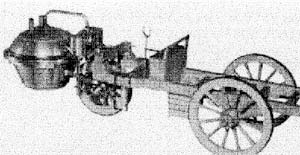
The limitations of battery power, the fractiousness of gunpowder, and the ponderousness of steam-powered mechanisms, however, precluded them from powering practical family vehicles at that time. A search ensued for an explosive fuel that could be controlled in a reasonably small engine.
In the mid-nineteenth century flammable gas, generated by heating coal in a pressure vessel or boiler, was already being piped into homes and factories for illumination. Such gas held out promise as fuel for stationary combustion engines. A gas engine was thus composed of both a coal-gas-generator and a mechanism in which the gas was mixed with air and exploded and pushed a wheel-connected piston through a tube. A Frenchman, Étienne Lenoir, designed and built such a gas engine in1860.
The Lenoir engine likewise could be considered as a stationary machine, fed by a gas line from an outside source, or connected directly to a coal-gas generator. It had a one-half horse power engine, a bore of 5 inches and a 24 inch stroke.8 Although less bulky than wood- or coal-fired steam engines, Lenoir's "car" remained too unwieldy for small vehicles on carriage roads. Nonetheless, "Lenoir hooked his engine to a carriage, and, although it was crude, it worked. It worked so poorly and so slowly (about one mile an hour) however, that he became discouraged and abandoned his efforts.9 Lenoir died penniless in 1900.
Lenoir missed the boat by not compressing a suitable gas into a liquid that could be stored in a container which could then be mounted on a vehicle as a reservoir of fuel. In modern times, the use of liquid compressed butane or propane gas are practical, somewhat cleaner and cheaper options as fuels to gasoline, benzine, or diesel oil. Liquified gas, however, can only function effectively as a fuel when used in conjunction with Siegfried Marcus' engine designs, as will be seen below.
The events that revolutionized explosion-powered engines began shortly after petroleum was first extracted in what is now southern Poland but was then part of Austria. Abraham Shreiner, a Galizianer (from Galicia) Jewish chemist, was the first to crack petroleum, that is, he refined a variety of products from the black, liquid mineral, some of which were volatile and explosive.10 These were the products which made the combustion engine a viable possibility. The research into petroleum products by Abraham Shreiner laid the foundation for the entire petroleum-based chemical and plastics revolution.
Abraham Shreiner's refinery and workshop burned down, and he died in penury. The Arabs, ironically, owe their largesse to a Jew!
At first, petroleum was refined mainly to produce oil for lubrication and kerosene for fuel. The burning of kerosene made it possible to produce steam on a vehicle more rationally than was possible with wood or coal, leading eventually to the production of the famous Stanley Steamer by the twin brothers Francis E. and Freelan O. Stanley in 1897. Scores of would-be inventors attempted to adapt such steam engines to family use. In addition to being bulky, these steam cars needed time for the burning kerosene to "steam up" the water in a tank. The efforts to utilize steam power for a family car finally faded away, including its use in several vehicles produced by Ramsey E. Olds, whose name survived his miniature locomotives.
In 1860, Dr. Nikolaus August Otto began working on a combustion engine that derived its power from the dispersion of volatile hydrocarbons, or of alcohol. The term vergassung (translating to "vaporization"), was employed to describe the process. Otto's engine did achieve some vaporization, but did it inefficiently. It mainly dispersed a spray of fine drops of liquid.
Had Otto succeeded in fully evaporating a hydrocarbon liquid he would have supplied one of the critical elements needed to displace steam engines and to free Lenoir's engines from the necessity of mounting a furnace to produce gas. Otto's engine, however, was inadequate in several respects. In addition to the fact that it did not vaporize hydrocarbon liquids efficiently, its two-stroke operation was mechanically inefficient. The engine operated in fits and starts, producing a loud clatter. As a stationary engine, it might, with further refinement, have eventually proved useful. A few Otto engines were commercially produced and achieved some success for industrial use.. The Otto motor, however, was entirely inadequate for empowering a wheeled vehicle. A steady speed, and the ability to finely control acceleration and deceleration is essential for a viable auto-mobile. The Otto engine could not provide or sustain a smooth, controllable transference of power. It was never so applied.
Siegfried Marcus pursued his research in the midst of this feverish mid-nineteenth century technological turmoil. Marcus pursued his work during the same period 4
as Lenoir, Otto, and other innovators of the times. He was familiar with what was going on and credited others for their innovations. Marcus, however, noted the limitations of the contemporary approaches to the development of a practical combustion engine. His genius lay in pursuing his own path. In so doing he alone breached all three of the roadblocks to the development of an efficient, hydrocarbon-based, internal-combustion engine by achieving effectual vaporization, reliable ignition, and mechanical efficiency. He invented an engine that, in addition to having an infinite variety of industrial applications, could also smoothly power a small, self-propelled vehicle that required neither steel rails nor a furnace, a true, practical auto-mobile.
1: The Carburetor
Marcus was already working on inventing an internal-combustion engine in 1860, the same year in which Lenoir first constructed a gas-powered engine. Marcus, however, set out to devise a combustion mechanism that could operate on a self-contained fuel.
Marcus first began experimenting with gunpowder as a motor fuel, but soon discarded it as too unreliable a process. Marcus turned to a highly volatile, potentially explosive hydrocarbon liquid, gasoline (benzine), a by-product of the refining of petroleum that was then being discarded. The inordinate volatility and flammability of the liquid made it perilous to handle. Nonetheless, since 1858, Marcus had been experimenting with achieving a system of illumination by igniting an mixture of a vaporized spray of the liquid with air with a stream of electrically-produced sparks. Marcus immediately recognized that if the violent reactions that resulted could be controlled, gasoline would become a valuable power source for a more effective, efficient, and more practical engine than one powered by steam.
The first technological obstacle that had to be surmounted was to create a mechanism that would dependably vaporize a hydrocarbon liquid in uniform, finely controllable amounts, add a suitably measured amount of air, to achieve a gaseous mixture that could be exploded behind a piston in a chamber. He succeeded in this endeavor with an apparatus he termed a vaporisater, "an apparatus for the [hydro]carbonization of atmospheric air." It was the forerunner of the carburetor. In 1864 it was installed on the first successful internal-combustion-powered engine ever produced.
Marcus continued
to improve his vaporisater
until he was satisfied that it functioned efficiently and reliably. His
first application for a patent was dated March 30, 1865. He was granted
the next privilege
(patent) for "an apparatus for the [hydro]carbonization of atmospheric
air" on June 1, 1866. Other improvements
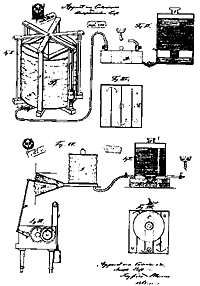
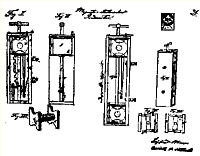
2: Electro-Magnetic Ignition
The second problem that Siegfried Marcus addressed was the ignition of a mixture of a vaporized hydrocarbon and air introduced into the chamber behind a piston at the precise moment when the mixture of the gases had been completed. The rate of ignition had to be able to accelerate or decelerate in concert with the force and frequency of the explosions. The resultant speed of the engine's action could thereby be increased or moderated with great delicacy. The Bunsen-burner-type igniter being commonly employed by those experimenting with gas as a fuel, could never achieve such precise and variable control.

Below: The world's first combustion-powered vehicle driven by Marcus in Vienna in 1864. Illustration from Ing. Alfred Buberl. Die Automobile des Siegfried Marcus
Marcus was well prepared for a resolution of the problem. His invention of electro-magnetic ignition was a culmination of his extraordinary pioneering work in the field of telegraphy, magnetism, and electricity. As was noted in Fact Paper 32-I, his creative aptitudes in those disciplines were demonstrated as early as 1853, when Marcus was instrumental in constructing an electrical-magnetic apparatus at the Academy of Medicine for the study of magnetism. Marcus went on to invent an electro-magnetic Zeichentelegraph or "needle telegraph indicator," in 1856, a Magnet-Elektrischen Induktor in 1858 The ignition device he produced for the Prussian Army Engineering Corps was followed by the electrishe gesteurte Zentralgeschüzabfeuerungignition, ("an electrically-activated firing ignition"), thereafter employed by the Prussian and other European armies and navies.
The "Viennese Igniter," as the latter Marcus invention became universally known, was the forerunner of automobile electro-magnetic ignition devices. In 1864 Marcus adapted the device to operate in conjunction with his carburetor by electro-magnetically activating a spark within a piston-operated mechanism, and found it suitable. Outfitted with his vaporisater and his magneto-elektrischen Zündinduktor, the engine performed so well that he mounted it on a cart, and geared it to the cart's rear wheels.
In 1864Marcus made a successful landmark run of his experimental model of a Ferdlos Fahrenden Wagon ("horseless carriage") in front of his workshop on Mariahilferstrasse. The vehicle had no clutch, and its rear wheels had to be lifted clear off the ground to be started. "[Siegfried Marcus] climbed aboard while a husky accomplice held the spinning rear wheels off the ground. With Marcus at the controls of the smoke-belching vehicle, the attendant let the wheels down and Marcus took off on a slow sixth-of-a-mile drive..."11
The first practical internal-combustion engine, and the first practical horseless carriage were born on Mariahilferstrasse in Vienna.
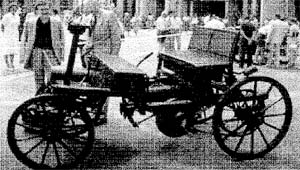
3: The Motor Mechanism
Having proved that his innovations made a gasoline engine suitable for powering a family-sized vehicle, Marcus proceeded to improve and add new features. The original cart with its attached engine did not survive, but photographs of it were taken in 1870. They provide a clear understanding of the mechanism. For the next two decades Marcus continued to improve the internal-combustion engine and its activating elements for both industrial and automotive purposes while inventing a host of other devices.
From 1868 to 1870 Marcus worked hard to refine the motor mechanically, and produced a vehicle that was designed specifically to displace the horse-driven carriage. In 1870 Marcus, evidently pleased with his updated carburetor and magneto, disassembled his experimental machine and built one that not only included these inventions but incorporated mechanical innovations that made it an entirely new type of vehicle.
"The second Marcuswagon is the first vehicle that earned the designation "Automobile."12
At the time, vehicles were pulled from the front by animals. Marcus determined that to reduce transmission length and facilitate steering, mounting the motor in the rear was more practical and economical. Many modern-day car producers are returning to that far-sighted innovation.
Marcus transmitted power through a metal-to-metal cone clutch, and the motor was belted to a solid rear axle. Marcus employed a center-pivot steering and shoe brakes.
Marcus developed a mechanically-operated slide inlet valve and a poppet exhaust valve. The valving system made it possible to control and direct the force of the explosion. Marcus' innovations made the internal-combustion engine a viable means for powering a family vehicle and for the trucks, the buses, the lawn mowers and the myriad of other useful machines so enormously responsible for the advance of civilization.
In his book Geschichte aus Meine Jugend, (Stories from my youth"), an author and friend of Marcus, Dr. Emil Ertl, describes a jaunt he took with Marcus on his automobile in 1871.
Tours on Marcus' automobile around Vienna taken between 1870 and 1872 achieved such success that they earned the patronage of Satori, mayor of Gmunden, a town some hundred miles west of Vienna. Mayor Satori established a grant of 25,000 gulden for the further development of the automobile, and allowed for further endowments. The mayor of that remote town evidently foresaw the future importance of the automobile for travel from his remote town to Vienna.
The Four-stroke Engine
The most vital internal-combustion engine innovations, the carburetor and magneto ignition, having now proven themselves, Marcus turned his attention to the development of a combustion cycle that would more smoothly and efficiently make use of the energy released. Marcus again demonstrated his genius in this endeavor by inventing a four-stroke engine with an action unlike any that had hitherto been conceived. Its mechanical attributes together with the Marcus carburetor and magneto are integral to virtually every internal-combustion engine in existence to this date.
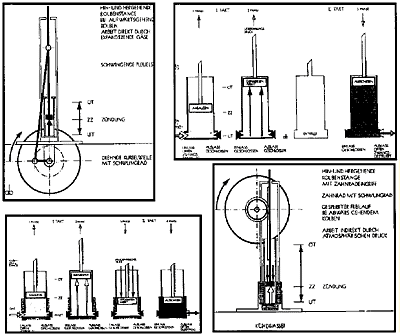
Buberl's comparative drawings of the Marcus and Otto four-stroke systems.
Top two illustrations:
The piston rod in the Marcus system is pushed up from below by the exploding gas mixture and transfers power through an articulated connecting rod.
Bottom two illustrations:
The piston rod of the Otto system is pushed downward by the exploding gas, and transfers power through a gear system.
This and other analytical drawings by Buberl make it clear that the two systems were based on different functional principles, and therefore Marcus did not adopt the Otto system but independently arrived at a superior mechanism that has survived into the present. Illustration courtesy of Ing. Alfred Buberl and the publishers of his book, Die Automobile des Siegfried Marcus.
From 1870 to 1875 Marcus focused on developing a mechanical action which would better accommodate the introduction of fuel, compression, explosion, exhaustion of the spent fuel, through a new four-cycle or so-called four-stroke engine. There were a number of entrepreneurs who were attempting this solution.. A French engineer, Alphonse Beau de Rochas, had already established the principle of the four-cycle operation as far back as 1862. An Austrian mechanic, Christian Reithmann, built a four-cycle engine in Munich in 1873. Dr. Nikolaus Otto of Germany is popularly credited with applying de Rochas work to an automobile engine in 1876, three years after Reithmann had developed it, and after Marcus employed a four-cycle engine in his third version of an automobile.
"Nikolaus August Otto was a merchant who dropped out of business to experiment with gas engines at the age of 22. He had a [two-cycle] atmospheric gas engine running in Cologne in 1862 and began production, selling about 50 units per year. Realizing the value of compression, he also invented charge stratification. His first experimental four-stroke engine ran in 1876, and his patent (No. 532) is dated Aug. 4, 1877. His small shop grew into Gasmotorebfabrik Deutz, where Gottrieb Daimler later worked as chief engineer."13 It has been repeated over and over again in virtually all automotive histories that Marcus adopted the Otto four-stroke mechanism. Buberl devotes much of his book and virtually an entire chapter to contrasting the Marcus four-stroke engine to that of the Otto engine and its antecedents. His parallel chronologies of the activities of the two inventors document the independent work of the two inventors on the development of a four-cycle engine during the same time period. Buberl submits a number of most detailed and definitive sets of mechanical drawings of every aspect of the two systems. They clearly delineate fundamental differences between the mechanical systems arrived at by Marcus and Otto. The Marcus system employs mechanical principles that have endured into the present. The Otto system has passed into the limbo of good ideas that were surpassed by superior ones.
One cannot be an adaptation of the other because they were operating under opposite principles. Only the general concept of arriving at a four-stroke cycle is common between them. The execution of that concept was entirely different.
As Buberl points out, even Goldbeck, who credits and lauds Marcus for his numerous landmark inventions and terms Marcus one of the greatest geniuses of all time, fell into the trap of repeating some of the false allegations about him.
Buberl, outraged by the common acceptance of this and an entire compendium of falsified history, devoted an entire chapter (53 pages!) to "Siegfried Marcus and his Opponents - Claims and Facts."13 In addition to debunking the deep-rooted misconception about the Marcus use of the Otto four-stroke engine, Buberl provides quotations from a wide variety of sources that had promulgated an entire range of historical misinformation about the invention of the automobile and about its inventor. Marcus was renowned and respected by his contemporaneous nineteenth century historians and technologists. But as the twentieth century wore on, this renown and respect was compromised by those who put forward Benz and Daimler as the originators of the automobile, and others who had more insidious purposes.
Anti-Semitism undoubtedly underlay the process of de-legitimization of Marcus' stature even before the Nazi period. In the process, Marcus' first experimental automobile was disregarded. Marcus' second automobile was stated to be his first, and since it was physically in evidence and could not be overlooked, its creation was updated to 1888, that is, after the first Benz and Daimler vehicles appeared!
It was said that, in any event, Marcus had no faith in the future of the automobile, in complete disregard of the fact that Marcus devoted so much effort to its perfection for more than twenty years. The age of the automobile began at the end of that period at a time that Marcus began to fail in health. Its leap-frog into existence thereafter was due entirely to the innovations Marcus had wrought. Marcus, regrettably, did not live to see the full development of the new era he was instrumental in creating. Nonetheless, a series of new patents testify to the fact that, never satisfied with his considerable successes, he continuously launched improvements upon elements of the internal-combustion engine. The development of the internal-combustion engine for industrial purpose was pursued. In 1880 a stationary benzinmotor for industrial use was patented and marketed. In that same year Marcus' third updated automobile was made public. It was designed to be put into production.14
There was a peripheral reason that the Marcus automobiles did not go into mass production soon after 1875, or at least soon after 1880. The advent of steam-powered vehicles sparked laws restricting the use of automotive machines on public roads in Europe and England. Stagecoach operators were afraid that horseless carriages would mean the end of their business, and the general public found that their horses were scared of the machines. Eventually in country after country experimenters were harassed and laws were passed forbidding the use of steam engines on roads. In England, Parliament passed the Locomotive on Highways Act in 1865. Popularly referred to as the "Red Flag Law," it stipulated that all self-propelled vehicles on public highways be limited to a maximum speed of four miles an hour and be preceded by a man on foot carrying a red flag to warn oncoming horse-drawn vehicles. Although the law was amended in 1878, it still retained the speed limit and required two people to operate the vehicle and a third to go ahead at danger spots, like intersections, and give a warning.
Automobiles were looked upon as even more of a menace, for they could no longer be restricted to specially built rail throughways. Evidently for this reason, in 1883, Marcus patented a Kraftmachine zum Antrieb aller Fahzeuge zu Wasser und zu Lande, ("A power-machine to drive on water and on land"). It is significant that although references to this patented engine appear in many contexts, "This often-cited patent is not to be found."15
The Landmark Motor-Car of 1875
It is clear, therefore, that Marcus' innovative work continued unabated, for his new inventions and innovations were incorporated in his third automobile that appeared in 1874 or early 1875, and in his subsequent fourth automobile. Unlike other entrepreneurs of the time, Marcus did not merely motorize horse-drawn carriages, but designed his vehicles in accordance with the new source of Buberl's comparative drawings of the Marcus and Otto four-stroke systems.
The frame and wheels were fashioned from oak, and the motor was affixed in the rear, "The vehicle weighed nearly 1000 pounds and boasted a throttle-control steering wheel, a hand clutch lever and a hand brake with brake shoes on the rear wheels only."16 The Encyclopedia Britannica adds that the auto was endowed "with a remarkably advanced electrical system."17 It was at first equipped with one of his two-cycle engines, and then his new, revolutionary four-cycle engine was installed. Marcus thus became the first to use such an engine in a transportation vehicle.
The attributes of those automobiles are truly remarkable. Siegfried Marcus' ground-breaking innovations made his combustion motor the standard for all those that followed. His innovations endured, and are presently integral to every internal-combustion-engine tool and mechanism extant today.
It was not until twenty-one years after Marcus' experimental car made its historic 200 meter run in 1864; not until fifteen years after tours around Vienna on Marcus' landmark four-seated motorcar of 1870 were recorded; not until ten years after Marcus outfitted a motorcar with a four-cycle internal-combustion engine did Carl Benz and his Jewish partner, Max Rose, build a "...three-wheeler [vehicle], powered by a one-cylinder engine."18 Later in that same year Gottlieb Daimler and his partner Wilhelm Maybach were working on a single-cylinder air-cooled engine. Such a

motor was affixed to a wooden bicycle that first ran on November 10, 1885. "The next year the first four-wheeled rod vehicle was made: "A carriage modified to be driven by a one-cylinder engine."19
In 1898 the Austrian Automobile Club arranged an exhibition of motor cars. Siegfried Marcus was officially appointed the Guest of Honor. His automobile was featured, and it remained on permanent exhibition at the Viennese Automobile Club. Until, that is, the Nazi Anschluss took place. The Nazi forces in Austria had specific instructions to destroy the Marcus machine and all photographs of its creation and existence, including all copies of a 1924 brochure that featured copies of the original photographs of the 1864 and 1874-5 models!20
Fortunately, some alert members of the Museum for Trade and Industry had the foresight to brick the machine up behind a cellar wall of the museum. "Marcus' second car, still operable, is now owned by the Austrian Automobile, Motorcycle and Touring Club in Vienna and is now on display at the Vienna Technical Museum."21
The automobile made a conspicuous run in a demonstration on the streets of Vienna in 1949-50 at the hair-raising speed of five miles (8 kilometers) an hour! Marcus' third and fourth version have not survived.
A Prolific Inventor
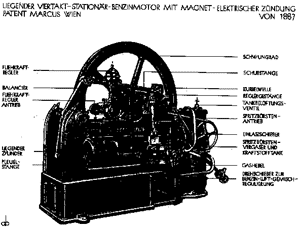
Marcus never patented an automobile per se, perhaps because he looked upon the motor and not the carriage as the essential element, thus making a registration of a motorized carriage redundant. Marcus patented the vital elements of the engine, and then patented a series of improved models of the engine itself. The engine had multiple applications, industrial as well as automotive. Marcus original four-cycle motor was specifically designed to propel a vehicle, and was proved out in landmark vehicles whose attributes are still in use to the present date, one hundred and thirty years later.
Marcus patented both standing and prone models of internal-combustion engines for industrial use. The construction of a series of models of these engines was let out to number of machine-works. Each new motor was improved mechanically and updated with improved and newly patented carburetors and magnetos. In 1883 an engine was produced by the machine works Schulz and Goebel; in 1884 by Ganz & Co., and in 1885 by Heilmann & Ducomun of Mulhouse. These were new, much more powerful Marcus engines. They were exhibited at the Exposition in Vienna in 1884and again in 1885 at the International Exposition in Antwerp.21a
Other inventions that Marcus created were likewise of great significance. The series of brilliant inventions by young Marcus documented in Fact Paper 32-I were but a prelude to those that followed. In the 1867 Paris exposition, where his electrical detonator and field telegraph were featured by many expositors, another successful product was introduced, a rotation system for the generation of electric light.
1876: Marcus patented an Automatischer Bildapparat, called "Revue," an automatic apparatus for making pictures.
1877: Marcus installed the first integral electrical lighting system in the Carlstheatre of Vienna. In that same year Marcus patented an electric lamp.
1879: An Eigentümlich Electrischer Glühlichtapparat (Rädchenelektrodenlampe) an electric light apparatus was patented. Marcus also patented an electro-magnetic carbon regulator, named "Simplex-Lampe."
1880: An improvement on galvanic elements, rendering them "unbreakable" and longer lasting.1883: An improvement on his internal-combustion engine; another innovative new form of internal-combustion engine; a new type of rotating machine which could be employed as a water-pump or for a means for the passage of vaporized or gaseous substances.
1885: A firing mechanism for ship's cannons that could be activated from the command bridge, extending his contribution to the German military beyond his classic detonator, field telegraph, and 30-shots-per-minute firearm.22
1887: A new Leucht-und Luftgasbrenner, an improved lighting system, and a new vertical engine.
1888: A new, innovative vehicle spring system.
1891: An improved gas-lamp whose incandescent body would be set in glowing ash.
1892: Marcus invented and patented an electric bell system; an improvement on his carburetor; a new innovative grill; a new rotating machine.
1893: A new type of thermo-element; a new type of galvanic element.
1894: An innovative bunsen burner, a system which would conserve and increase its temperature; an innovative improvement on the lighting of a gas-lamp that would operate efficiently out in the countryside on the fields; another improvement on the bunsen burner.
1895: A new type of lamp using liquid hydrocarbons. A new carburetor-lamp especially for incandescent lighting; a patent in July for a new type of lamp for hydrocarbons.
1896 Marcus patented a new type of oil burner; another innovation in carburetor combustion.
Buberl notes that it is also known that Marcus invented a loudspeaking microphone, an electric lighter and an instantly solidifying lead compound. In addition to the above patents on record or referred to in technological journals there are another hundred or more innovations that can be attributed to Marcus with some certainty.
Goldbeck notes that the Journal of the Viennese Society for Electrotechnology, (of which Marcus was a charter member since its foundation in 1883), published sixteen articles about his new inventions as they came forth.23 These articles, and articles about his inventions in other contemporary journals (like Dinglers Polytechnischen Journal), were never written by Marcus himself. "The development of his ideas was the powerful leitmotiv of Marcus' life. Marcus had little interest in industry, he wished only, that his concepts become realized."24 The income Marcus received from his patents, as well as from his successful workshop, was plowed back into the innovative projects Marcus loved.
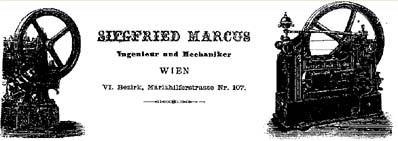
Siegfried Marcus has earned a prominent seat at the highest level of the inventor's hall of fame. The renown and respect he enjoyed through the latter half of the nineteenth century was stolen from him in the twentieth. It is time to reverse the process of exclusion and obfuscation the work of this genius has suffered. It is time that encyclopedias, textbooks, and technological histories reflect the truth, and the whole truth about the enormous contribution Siegfried Marcus has made to modern civilization.
It is time that every schoolchild learns the name of the true inventor of the automobile, Siegfried Marcus.
Notes
Much thanks is due to Heinz and Edith Schultz of Highland, NY for their help in translating obtuse German documents, and to Kurt Pfennig of Braunshweig, Germany, who went through considerable effort to obtain such documents.
1: Buberl, Die
Automobile de Siegfried Marcus, Vienna, Edition Tau & Tay Type
Niricz, 1994, 57
1a: Buberl, Ibid/, 47.
1b: HHF Fact Paper 32-I.
2: Encyclopedia Americana "Automobile," 1995.
3: Cecil Roth, The Jewish Contribution to Civilization, London,
University Press, Aberdeen, 1956. 157.
4: Compton's Encyclopedia, www.optonline.com/comptons/ceo/00357_A.html.
5: HHF Fact Paper 3, "The Silk Route; A Judaic Odyssey."
6: Comptons Dictionary at optonline.com/Comptons/ceo/00357_A.html
6A: Roth, Ibid., 157.
7: Cecil Roth, Ibid., 1956
7A: HHF Fact Paper 32-I
8: William Bottorff, The First Car? A Quick History of the Automobile,
ausbcomp.com/~bbott/cars/carhist.htm
9: ICP Educational Resources at: icpeducational.com/auto101/histtext.html
10: Roth, Ibid., 157.
11: Knowledge Adventure, Inc. letsfindout.com/subjects/people/Siegfried-marcus.html
12: Buberl Ibid., 178.
13: Buberl Ibid., 116-69.
14: Buberl, Ibid., 205.
15: Buberl Ibid., 205
16: Automotive News www. houston.webpoint.com/newcars/an990725.htm.
17: Britannica, idem.
18: Britannica, 1973, "Automobile."
19: Britannica, idem
20: Britannica, idem.
21: Technical Museum, Mariahilferstrass 212, A-1140 Vienna, Austria.
asme.org/history/roster/H203.html\
21a: Meyers Universal Lexicon, VEB. DDR 1982, Bande 4, 296-7.
22: HHF Fact Paper 32-I.
23: Goldbeck, Ibid., 61.
24: Goldbeck, Ibid., 62.
